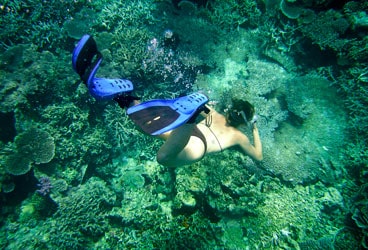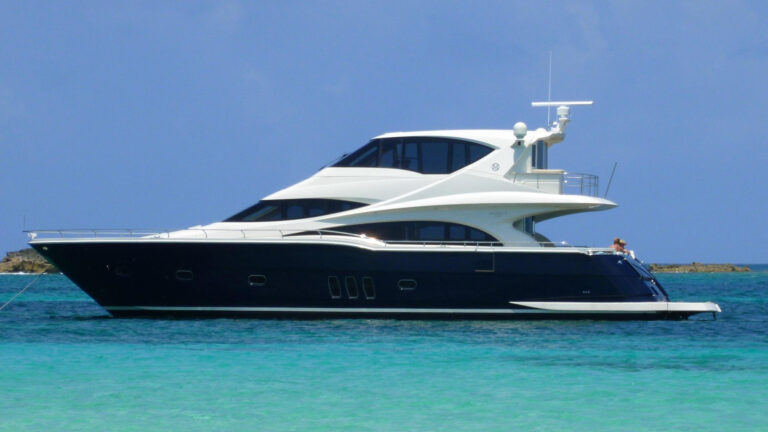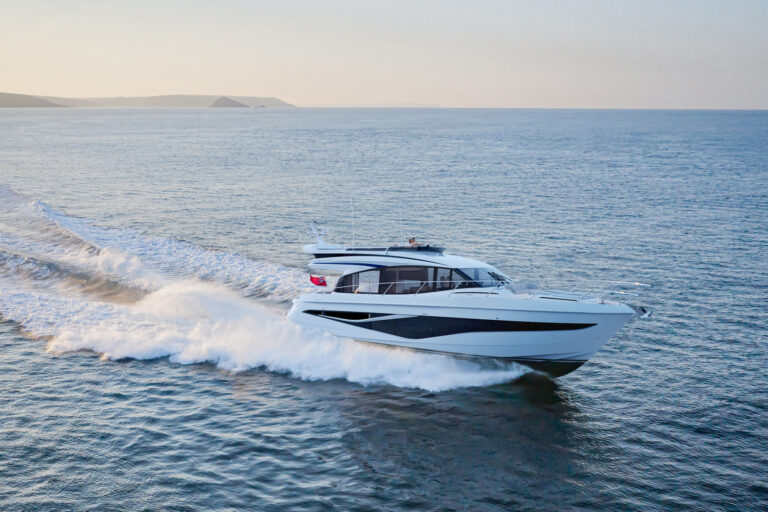
Around the World Aboard Whale Song
In our June issue, Tom Zydler recounted the second portion of Whale Song’s great round-the-world adventure from Antarctica to the Philippines. We rejoin the ship, a 94-foot Trinity Halter Global Explorer yacht, and its crew — owner Grant Wilson, captain Tom Zydler and first mate Nancy Zydler, Tom’s wife — as they set off for Palau.
Cebu to Papua New Guinea
A good while ago, Magellan, the great navigator, leading the first Europeans into the Philippines, met a violent death on Cebu Island. We felt considerably safer than he must have in Lapu-Lapu City on Cebu, our last stop in the country. Among our guests was Johnny Bivera, Grant Wilson’s son-in-law, a top U.S. Navy photographer and a direct descendant of Chief Lapu-Lapu, who led the fight against the Spaniards some 500 years ago. We began thinking about the fate and lasting curse of history when the windlass died suddenly while pulling off the fuel wharf. The housing of the oil filter cracked, spilling gallons of oil. Lucky for us a hydraulic shop across the channel had the replacement. With that fixed, the bow thruster tunnel began dripping seawater, and its repair would require a haul-out — later, in Australia, we decided.
Typhoons became a distant memory on the way to Palau — the glassy ocean reflected towers of cumulonimbus like a trick mirror. At sunset and dawn, cloud heads aflame seemed like a vision of nuclear holocaust. Palau, a nation of 200 islands populated by 21,000 people, is divided into 16 very small states; the state of Hatohobei (two square miles) has 44 inhabitants. The natives are friendly; tourism flourishes because scuba divers flock to the reefs, wrecks and atolls, which are some of the Pacific’s best. The most unforgettable Palau memory is the dinner ashore before our morning departure for Papua New Guinea. When the lid came off the bowl with the fruit bat pie, a well-done whole bat bared its teeth at us in a silent scream of pain. Bon appétit!
Papua New Guinea to the Solomon Islands
After clearing in to Wewak on the north shore of Papua New Guinea, owner Grant Wilson hired a pilot to help with navigation up the Sepik River. Off the first village after the river bar, canoes paddled out to intercept Whale Song and sell exquisite wooden masks. Sepik men carve compulsively — full-size crocodile heads (and even bodies!) are carved into the bows of their canoes. Shaped posts support their homes. In most settlements the giant head of some mythical creature stands out from the gables of the village’s biggest structure — haus tambaram — the men’s spirit house. At Ambunti, 200 miles upriver, Whale Song had to turn back. We were running out of water.
The name Papua New Guinea challenges what the word country implies. The count varies as to how many languages are spoken there. If it weren’t for “pisin Englis,” lingua franca on all islands, the family on Crown Island wouldn’t understand the Unea Islanders, 90 miles away, or the people on Garove Island. Johan Albrecht Harbor on Garove is set in a crater, surrounded by the walls of an extinct volcano. But two days later, on New Britain, Whale Song anchored near a live one. Tavurvur belched ashes and flames and shot pumice rocks that incongruously bobbed in a little bay under the volcano. Rabaul, a busy port town in its shadow, was still digging out from under mud and ashes.
Papua New Guinea shares seismic unease with the Solomon Islands, where we chugged past grand steaming cones on the way south. On New Georgia, a red roof prominent above the tree line marked the entrance to Lever Harbour. A settlement of five families in bamboo huts lay low around the skeleton of a church under prolonged construction. A 6-foot-long split gong called people to worship. When the trading began — baskets, carved paddles and bone fishhooks for cold drinks, rice and sugar — settlement resident Roxon Tender Love offered us megapode eggs. The birds usually lay them in hot volcanic sand, but Love attracted them by putting a roof over a midden of warm fermenting food scraps. The eggs were huge. Barbara Parks, our cook, needed only one for three banana cakes. Our visit here went so well that we were invited to go boar hunting — with spears and dogs as our weapons!
Solomon Islands to Australia
We left Honiara, the Solomons’ capital on Guadalcanal Island, on schedule. The delay came a few hours later when a low-pressure system to the southeast matured into a cyclone. The wind and seas built from the west. I turned Whale Song northwestward behind the Russell Islands. With 800 miles between us and Cairns, Australia, the chance of running into a cyclone made us nervous, but luck was on our side. The system turned north and we went southwest. Out in the Coral Sea, waves sparkled blue and silver under puffy tradewind clouds and red-footed boobies dive-bombed on flying fish that took off from Whale Song’s foaming bow wave.
A popular vacation destination, Cairns, in Queensland, Australia, has everything a voyaging yacht needs. We drove Whale Song into a dry dock big enough to take vessels double our size. A new gasket fixed the bow thruster leak and left us some time for exploring. The town galleries ranged from tacky tourist stuff to sublime symbolic aboriginal art. A boardwalk along the waterfront served as a gallery of bird life — royal spoonbills, white pelicans, ibises, whimbrels, masked lapwings, godwits, curlews and dowitchers were just yards away. Trips into the rainforests changed our misperception of Australia as a country of one vast desert.
Australia to Indonesia
Grant Wilson decided to swing through Papua New Guinea again on the way to Indonesia. Whale Song anchored in the lee of Endeavour Reef, the same that nearly finished James Cook’s ship in 1770, but the strong northwest monsoon muddied the sea too much for diving. Forty hours after weighing anchor from Lizard Island, Queensland, a full moon lit the way through Sunken Barrier Reef, Papua New Guinea, where we once again entered the world of the unexpected. In Posa Posa Harbor on Cape Vogel, my wife, Nancy, pulled tender watch as the rest of us plunged inland through the mangrove forest mud looking for a traditional boatbuilder. Nancy was fighting mosquitoes when a couple of girls paddled in. It took them just a few minutes to rub dry sticks, start a smoking fire and ask this blue-eyed blonde if she were Japanese. At Goodenough Island, five dozen canoes full of villagers fought to tie up alongside us and trade.
Our next stop, the Trobriands, sprang into the outer world’s attention with the work of Bronislaw Malinowski (1884-1942), the father of social ethnography. They are still regarded as a hotbed of free love, where women chase men during the annual yam festival. Whale Song anchored off Losuia, on Kiriwina Island, way before the yam festivities. Instead of brown goddesses we were pursued by relentless (but gifted) carvers of ebony. Streams of lakatoi, sailing catamarans, passed by, loaded with branches of the mildly narcotic betel plant. The seas here teemed with life. Leprena, a sloop owned by an Aussie and his native wife, came alongside for dinner. In the dark, after they had cast off, the fenders were covered with newborn squid, their dark eyes too big for bodies less than an inch long.
Indonesia spans a universe of islands too vast to take in at once. The country expanded after the Dutch colonial power vanished in the aftermath of World War II. The western part of Papua became Irian Jaya. Fly inland from the port of Jayapura, where Whale Song anchored, and you will enter the realm of mountain Papuans. In Baliem Valley, Wilson, his friend Art Milliken and two of the crew walked side by side with men, naked but for their penis gourds, and women in the world’s lowest grass skirts.
On the island of Biak, Wilson dived on a downed World War II Japanese plane, accompanied by the local divemaster, Abraham, a Papuan Christian who had strong words about the Muslim invasion directed from Jakarta. At Pulau Manuk we dove among hordes of sea snakes weaving their way under our arms. Komodo Islands delivered more excitement. One morning a massive Komodo dragon foraged on the beach near the anchorage. Our tender was full of camera-wielding humans grounded some yards away. The dragon flicked his tongue and made a beeline for us, but it was not fast enough to outpace a 115-horsepower outboard.
Cultures from the long-forgotten past thrive in secluded places. People in Lamalera on Pulau Lembata spear sperm whales from open sailboats. But they never attack blue whales. A legend claims that blue whales carried their ancestors to safety when a volcano buried their homes. Even on an island as assaulted by international tourism as Bali, it took only a short trip to see people who had preserved their traditions. The ancient Ubud, inland from the port of Benoa, maintains its sacred monkey temple and streets of sacred Hindu sites carved in stone, and even older indigenous burial plots lie just paces from the tourist bus terminal. Off small coastal hamlets trimarans of ancient design work the fertile waters.
Indonesia to Thailand
In the Singapore Strait, Whale Song joined the throbbing traffic. The great, open seas of Papua New Guinea and Indonesia seemed so very far away. When the sun set, a thousand lights appeared, except on small, shadowy vessels scooting across rows of ships passing Singapore for the Strait of Malacca.
We anchored offshore of Malacca, which was an important trading depot in the 15th century. Portuguese, Dutch, English, Chinese, Hindu and Buddhist architecture commemorated the ups and downs of nations that tried to monopolize this crossroads of Far Eastern trade. Today, fed by the semiconductor and garment industries, Malaysia banks on the future.
We loved the Ratanachai shipyard in Phuket, Thailand, where a holy man blessed the haul-out way before Whale Song rode out of the water. A small Buddhist temple right under our bow came to life once a week when the yard owners set up tables with food. At launching, every vessel’s bow was wrapped in prayer banners, and firecrackers accompanied the slow slide back to sea. Our work list was long (see “Haul-Out Repairs,” left), and we looked forward to utilizing the splendid working attitude of Thai craftsmen and their Burmese assistants.
Be sure to read the conclusion of Whale Song’s voyage in our August Adventure issue.









